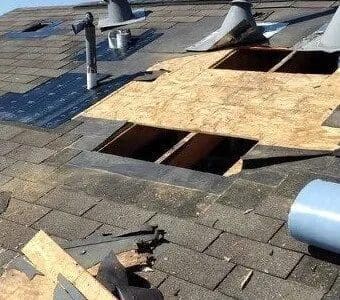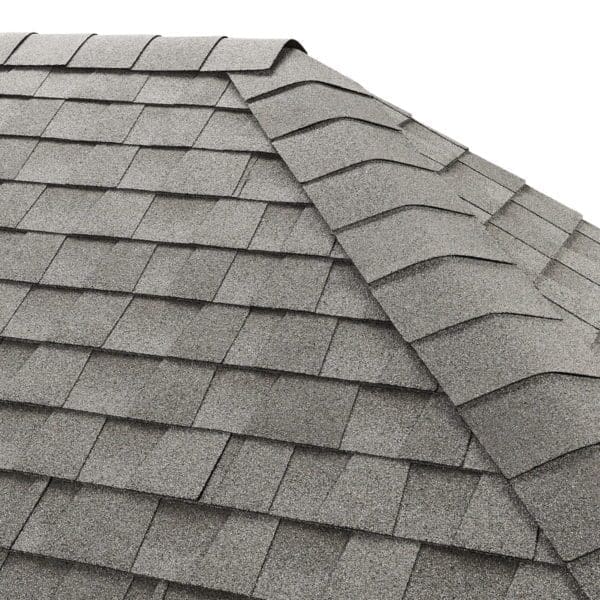What is a Roof Replacement?

Getting the news that you need a roof replacement is never a fun thing to hear. Unfortunately, there’s nothing you can do expect learn as much as you can before starting the process.
I understand doing research is time consuming and overwhelming. But it’s crucial to be as informed as possible. With over 30 years experience, the team at fortheclaim.com has helped homeowners like you get ready for their roof investment. So we will give you the info needed to start your roof replacement journey. In this article, you’ll learn what a roof replacement is and the 6 things you need to know about getting your new roof.
What is a roof replacement?
So, what is a roof replacement? A roof replacement is tearing off your old roofing materials down to the decking and installing all-new roofing components (underlayment, shingles, etc.).

Keep in mind, just because your roof is leaking doesn’t mean it needs a replacement. The remedy to your leaky roof will always depend on what your roofing contractor finds during your roof inspection.
Be aware, a new roof is an investment. Just like every other investment, it isn’t going to be cheap. Some people who are on a tight budget choose a nail-over instead of a full roof replacement. A nail-over cuts crucial steps out of the replacement process but saves money on materials and labor.

A roof replacement is a process in which the old roofing material on a home or building is removed and replaced with new material. This is typically done when the existing roof is in poor condition and cannot be repaired, or when the homeowner wants to upgrade to a new type of roofing material. Roof replacements can be a significant investment, but they are often necessary to protect the home from leaks, water damage, and other problems.
There are several factors that can influence the need for a roof replacement, including the age of the roof, the condition of the roofing material, and the type of roofing material used. For example, asphalt shingles, which are the most common type of roofing material in the United States, typically last for 20 to 25 years. If the roof is older than this and is showing signs of wear and tear, it may be time to consider a replacement. Similarly, if the roof is damaged by a storm or other event, a replacement may be necessary to repair the damage.
When it’s time to replace a roof, the first step is to remove the old roofing material. This may involve tearing off the old shingles, as well as any flashing, drip edge, and other components of the roof. Once the old roofing material is removed, the roof deck (the plywood or other material that forms the base of the roof) will be inspected for any damage. Any damage will need to be repaired before the new roof can be installed.

After the roof deck is repaired, the new roofing material can be installed. This may involve installing a new layer of shingles, as well as flashing, drip edge, and other components. The new roofing material will be secured in place using nails or other fasteners, and the edges will be sealed with roofing cement.
Once the new roof is installed, it’s important to perform regular maintenance to ensure that it stays in good condition. This may involve cleaning the roof to remove leaves, branches, and other debris, as well as inspecting it regularly for any signs of damage. By performing regular maintenance, you can help extend the life of your roof and protect your home from leaks and other problems.
In summary, a roof replacement is the process of removing the old roofing material on a home or building and installing new material in its place. This is often necessary when the roof is in poor condition or when the homeowner wants to upgrade to a new type of roofing material. A roof replacement can be a significant investment, but it is often necessary to protect the home from leaks and other problems.
6 things to know before getting a roof replacement
You just learned what a roof replacement is. Now you need to know 6 key things about getting your new roof. Hiring a local roofing contractor, investing in quality, and more helps you get started on the path to getting your new roof.
1. You need to know whether you really need a roof replacement
Remember, just because your roof has a leak doesn’t mean you need a new roof. Before replacing your roof, your local roofing contractor will determine if you need a full replacement or just repairs.
As long it’s properly installed and properly ventilated, your roof will get as close as possible to the manufacturer’s specified life span. For example, a 3-tab asphalt shingle roof’s lifespan is around 25 years. So, if your 3-tab asphalt shingle roof is only 10 years old, you shouldn’t need a replacement for at least another 12 years.
Even if you have a roof leak, your contractor can do repairs to get you through until it’s time to replace it. A roof replacement never comes at a convenient time, but there are signs that tell you it’s time for one.
Ultimately, it’ll be up to what your local roofing contractor finds during their inspection if you need a roof replacement.
2. Hire a local roofing contractor for your roof replacement
Hiring a local roofing contractor is crucial to your roof investment. The local roofing contractor you hire must have a physical office location in your area and a local phone number. This ensures you know where to find them if you ever have a problem with your roof.
Another reason to hire a quality local roofing company is that they know what needs to be done that’s specific to the area where you live. They’ll know what installation codes to follow, the paperwork required, and everything else they’ll need to ensure your roof is correctly installed and in compliance with your state’s requirements.
Be aware that some out of state companies come in after a big storm, undercut local roofing company prices, get the money, and move on to the next storm-hit town. These companies don’t care about local codes or if they properly install your roof.
3. Invest in a quality roof replacement
A roof replacement is an investment. And just like every other investment, your replacement isn’t going to be cheap.
I understand everyone is on a budget, and a low price may drive your decisions. However, it’s crucial to your roof investment that you choose quality materials and labor instead of going with the cheapest options available.
If you decide to go with the cheapest roof, you’re getting the cheapest roofing materials with the cheapest labor to install them. When you pay for this cheap labor and materials, it shows in the finished quality of your roof, which will cost you more money in the long run with repairs and eventually, a full roof replacement.
4. The roofing materials included in your roof replacement
Your roof is more than just the shingles you see from the street. So, wouldn’t it make sense to know what else makes a roof a roof?
Your roof is made up of different roofing materials and components that form a complete roof system. Be aware, not all of these materials (decking and flashing) will need to be replaced when you get an asphalt roof replacement.
The roofing components and materials that make up your roof are:
- Roof decking
- Roof flashing
- Underlayment
- Drip edge
- Ice and water shield
- Shingles
- Ridge capping
- Roof vents
- Pipe boots
Remember, it’s crucial to invest in quality when it comes to roofing materials. This ensures you get the best materials warranty available from the manufacturer.
5. What the roof replacement process looks like
The day your roof is installed is the most important day in the life of your roof. It must be installed using correct roofing techniques to truly give you peace of mind. But what does the roof replacement process look like?
The first step to your roof replacement is getting all the roofing materials delivered to your home. Then your local roofing contractor arrives on the day of your replacement and makes sure all the vehicles are moved out of your driveway or garage.
After making sure everything is clear for them to start, they’ll start setting up protection for your property and begin the tear-off process. After your old roof is torn off to a clean decking, they’ll begin installing all of your new roofing materials.
Once your new roof is properly installed, your contractor will clean up your property and inspect your new roof to ensure the workmanship reaches the high standards you expect.
6. How long your roof replacement will last
After your new roof is installed, you’ll have a new roof that’ll stay leak for decades to come. But how long will your new roof actually last?
Your roof will get as close as possible to the manufacturer’s specified lifespan as long it’s properly installed and properly ventilated. With that in mind, you should get around 80-85% of the life span out your roof.
For example, a dimensional asphalt shingle roof (the most common type of roof) has a lifespan of 30 years. This means you can expect to get 25-28 years out of your dimensional shingles.
Remember, these numbers are based on your roof being installed using correct roofing principles and having adequate attic ventilation. If it doesn’t, your roof’s life will be cut short and you’ll have to go through the roof replacement process all over again.
How much will your roof replacement cost?
Now you know what a roof replacement is and the 6 things you need to know before getting one. After reading this, you have the knowledge you need to to get started with the roof replacement process.
However, there’s still one more thing that every homeowner is concerned about when getting a new roof, the price. Unfortunately, the roofing industry doesn’t like to talk about this.
But because we want you and every other homeowner to know what to budget for, we broke down the cost of a roof replacement.
The team at fortheclaim.com has been providing high-quality roof replacements to local residents since 2019. Our workmanship ensures you get a new roof that lasts for decades. That’s why we offer a lifetime warranty.